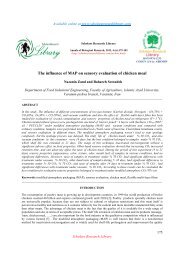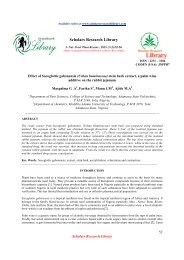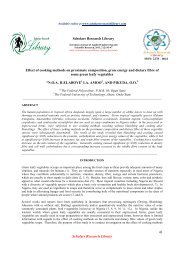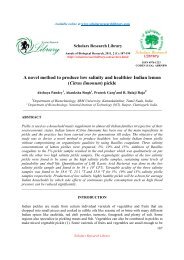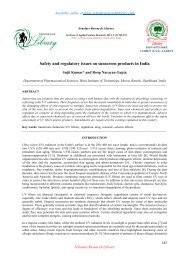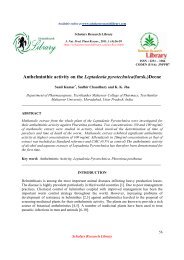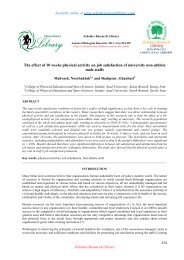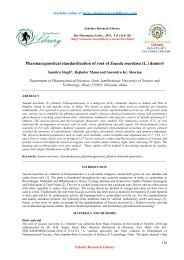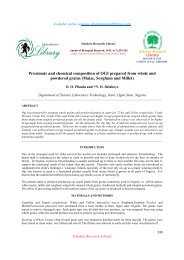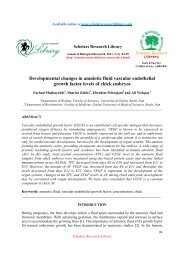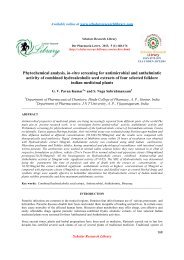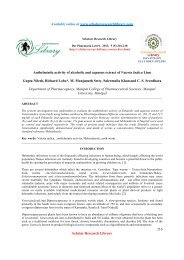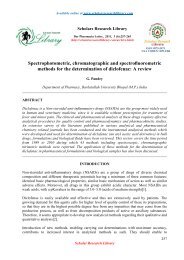Anthelmintic activity of Cassia auriculata L. extracts-In vitro study
Anthelmintic activity of Cassia auriculata L. extracts-In vitro study
Anthelmintic activity of Cassia auriculata L. extracts-In vitro study
You also want an ePaper? Increase the reach of your titles
YUMPU automatically turns print PDFs into web optimized ePapers that Google loves.
Available online at www.scholarsresearchlibrary.com<br />
Scholars Research Library<br />
J. Nat. Prod. Plant Resour., 2011, 1 (2): 62-66<br />
(http://scholarsresearchlibrary.com/archive.html)<br />
ISSN : 2231 – 3184<br />
CODEN (USA): JNPPB7<br />
<strong>Anthelmintic</strong> <strong>activity</strong> <strong>of</strong> <strong>Cassia</strong> <strong>auriculata</strong> L. <strong>extracts</strong>-<strong>In</strong> <strong>vitro</strong> <strong>study</strong><br />
Sucheta A Gaikwad*, Asha A. Kale, Balaso. G. Jadhav, Nirmala. R. Deshpande and Jyoti.<br />
P. Salvekar<br />
Dr. T. R. <strong>In</strong>gle Research Laboratory, Department <strong>of</strong> Chemistry, S. P. College, Pune<br />
_____________________________________________________________________________<br />
ABSTRACT<br />
Helminth infections are among the most common infections in humans, affecting a large<br />
population <strong>of</strong> the World. Use <strong>of</strong> herbal products as antimicrobial agents may provide the best<br />
alternative to the wide and injudicious use <strong>of</strong> synthetic antibiotics. Albendazole, the commercial<br />
anthelmintic drug is used as a standard reference and saline as control. As per WHO, only few<br />
drugs are frequently used in the treatment <strong>of</strong> these parasite infections <strong>In</strong> present <strong>study</strong> acetone,<br />
ethanol, methanol and quath <strong>extracts</strong> <strong>of</strong> <strong>Cassia</strong> <strong>auriculata</strong> L leaves were investigated for their<br />
anthelmintic <strong>activity</strong> against Ecinia foeitida. Three concentrations (5, 10, 20 mg/ml) <strong>of</strong> each<br />
extract were studied. This experiment involved the determination <strong>of</strong> time <strong>of</strong> paralysis and time <strong>of</strong><br />
death <strong>of</strong> the worms. The gradual increased in a dose exhibited, a gradual increase in the <strong>activity</strong>.<br />
Quath and ethanol <strong>extracts</strong> displayed significant anthelmintic <strong>activity</strong> at highest concentration <strong>of</strong><br />
20 mg/ml. It was concluded from the experimental detail <strong>study</strong> that the plant revealed significant<br />
anthelmintic <strong>activity</strong>, therefore in vivo trials may be conducted for the use in livestock on<br />
scientific basis. The data were verified as statistically significant by using two way ANOVA at<br />
1% level <strong>of</strong> significance (P-value < 0.01)<br />
Keywords: C. <strong>auriculata</strong> L, anthelmintic <strong>activity</strong>, Ecinia foeitida, leaves <strong>extracts</strong>.<br />
______________________________________________________________________________<br />
INTRODUCTION<br />
Helminthiasis or worm infection is one <strong>of</strong> the most prevalent diseases in the World. The<br />
conditions appear to be worsening with respect to the number <strong>of</strong> persons affected[1]. The WHO<br />
estimates that a staggering two billion people harbor parasitic worm infections. Parasitic worm<br />
also infect livestock and crops, affecting food production with a resultant economic impact.<br />
Despite this prevalence <strong>of</strong> parasitic infections, the research on anthelmintic drug is poor[2].<br />
Helminth infections are among the most common infections in humans, affecting a large<br />
population <strong>of</strong> the World Although the majority <strong>of</strong> infections due to worms are generally limited<br />
Scholar Research Library<br />
62
Sucheta A Gaikwad et al J. Nat. Prod. Plant Resour., 2011, 1 (2): 62-66<br />
______________________________________________________________________________<br />
to tropical regions and pose a great threat to health and contribute to the prevalence <strong>of</strong><br />
malnutrition, anaemia, eosinophilia and pneumonia[3].Parasitic diseases cause severe morbidity<br />
affecting mainly population in endemic areas with major economic and sol consequences[4]. The<br />
gastro-intestinal helminthes becomes resistant to currently available anthelmintic drugs therefore<br />
there is a foremost problem in treatment <strong>of</strong> helminthes diseases[5]. There is an increasing<br />
demand towards natural anthelmintics. The plant C.<strong>auriculata</strong> L. is an aromatic more or less<br />
deciduous shrub found through out <strong>In</strong>dia up to an altitude <strong>of</strong> 1,500 m commonly in forests. C.<br />
<strong>auriculata</strong> L. (Caselpinaceae) is a tall, much branched bushy shrub growing wild throughout<br />
forests and along roadsides and in wastelands. Literature survey reveals that leaves <strong>of</strong> C.<br />
<strong>auriculata</strong> L are useful in treatment <strong>of</strong> leprosy, ulcers and have anthelmintic <strong>activity</strong>[6]. The<br />
anthelmintic <strong>activity</strong> <strong>of</strong> quath extract <strong>of</strong> the leaves is reported[7]. The plant is reported for the<br />
presence <strong>of</strong> polyphenolic compounds.anthelmintic <strong>activity</strong>, chemically tannins are polyphenolic<br />
compounds[8]. Some synthetic phenolic anthelmintics e.g. niclosamide, oxyclozanide and<br />
bithionol are shown to interfere with energy generation in helminth parasites by uncoupling<br />
oxidative phosphorylation[9]. Another possible anthelmintic effect <strong>of</strong> tannins is that they can<br />
bind to free protein in the gastrointestinal tract <strong>of</strong> host animal or glycoprotein on the cuticle <strong>of</strong><br />
the parasite and cause death[10].The present <strong>study</strong> investigates the anthelmintic <strong>activity</strong> <strong>of</strong> the<br />
leaves for the different <strong>extracts</strong> with a view to justify the use <strong>of</strong> the plant in the treatment <strong>of</strong><br />
helminths.<br />
MATERIALS AND METHODS<br />
1. Plant materials and preparation <strong>of</strong> <strong>extracts</strong><br />
<strong>Cassia</strong> <strong>auriculata</strong> L was collected from Western Pune, Maharashtra, <strong>In</strong>dia. The taxonomic<br />
identification was carried out with the help <strong>of</strong> Flora <strong>of</strong> Botany Presidency and Flora <strong>of</strong><br />
Maharashtra (Singh et al.2000) and herbaria were prepared by following standard methods. The<br />
specimens were also compared with the authentic herbaria <strong>of</strong> BSI, Western circle<br />
Pune,Maharashtra,<strong>In</strong>dia for confirming the identification, its number is BSI/WC/Tech/2009/95.<br />
Air shade dried and pulverized plant material was used. Extracts were prepared using exact<br />
weighed sample powder in the measured volume <strong>of</strong> solvents like, acetone, ethanol, methanol<br />
and quath.Vaccum dried extracs are used for the experiment.Solvents used after distillation.<br />
2. Phytochemical screening<br />
Qualitative assay, for the presence <strong>of</strong> plant phytoconstituents such as carbohydrates, alkaloids,<br />
glycosides, flavonoids, tannins and saponins were carried out on following standard procedure<br />
[7,11].<br />
3.Collection <strong>of</strong> Animal<br />
The anthelmintic assay was carried as per the method <strong>of</strong> Ajaiyeoba et. al. [9,14] with minor<br />
modifications[12,15]. The assay was performed on adult earthworm (Eicinia fetida) owing to its<br />
anatomical and physiological resemblance with the intestinal roundworm parasites <strong>of</strong> human<br />
beings[13,14]. Easy availability <strong>of</strong> earthworms prompts their extensive use for preliminary in<br />
<strong>vitro</strong> evaluation <strong>of</strong> anthelmintic compounds[10]. Earthworms were provided and identified by<br />
Dept. <strong>of</strong> Entomology, College <strong>of</strong> Agriculture, Pune,Maharashtra,<strong>In</strong>dia. All earthworms were <strong>of</strong><br />
approximately equal size (15 cm). They were washed with saline before experiment.<br />
Scholar Research Library<br />
63
Sucheta A Gaikwad et al J. Nat. Prod. Plant Resour., 2011, 1 (2): 62-66<br />
______________________________________________________________________________<br />
4. Drugs<br />
Albendazole was purchased from G.S.K. Pharma Pvt ltd, Mumbai along with saline NA 0.91 %<br />
NaCl . The solvents <strong>of</strong> analytical grade were used during experimental protocol.<br />
Experimental<br />
Quath, ethanol, methanol, ethylacetate, <strong>extracts</strong> <strong>of</strong> Plant material investigated for their<br />
anthelmintic <strong>activity</strong> against Ecinia foeitida. The anthelmintic assay was carried as per the<br />
method <strong>of</strong> Ajaiyeoba et. al.[9] with minor modifications. All the test solutions and standard drug<br />
solutions were prepared freshly before starting the experiment. Six groups <strong>of</strong> earthworms <strong>of</strong><br />
approximately equal size were released in to 25 ml solutions <strong>of</strong> three different concentrations<br />
(5,10,20 mg/ml) in petri dishes containing above solutions <strong>of</strong> <strong>extracts</strong>. Albendazole was used as<br />
reference standard and saline as control. Determination <strong>of</strong> time <strong>of</strong> paralysis and time <strong>of</strong> death <strong>of</strong><br />
the worm were done. Time for paralysis was noted when no movement <strong>of</strong> any sort could be<br />
observed except when the worms were shaken vigorously. Time for death <strong>of</strong> worms was<br />
recorded after ascertaining that worms neither moved when shaken vigorously nor when dipped<br />
in warm water (50 o C) followed with fading away <strong>of</strong> their body colours.<br />
Ethanopharmocological Relevence<br />
The plant species screened in this research was recorded by several indigenous medicinal<br />
practitioners as antiparasitic, anticancer and/or related activities to the human major organ<br />
system.<br />
Table I Shows <strong>Anthelmintic</strong> Activity results <strong>of</strong> <strong>Cassia</strong> <strong>auriculata</strong> L. Extracts.<br />
Eicinia foeitida (Earthworms)<br />
Extracts Concentrations<br />
mg/ml<br />
Time for<br />
paralysis(P) in min.(Mean &SEM)<br />
Time for death (D)in min.<br />
(Mean &SEM)<br />
Control(Saline) ------ ----- ------<br />
5 76±0.190 182±0.022<br />
Quath<br />
10 61±0.020 83±0.020<br />
20 44±0.019 67±0.019<br />
5 70±0.020 132±0.022<br />
Ethanol<br />
10 45±0.020 55±0.021<br />
20 30±0.019 50±0.020<br />
5 96±0.020 191±0.020<br />
Methanol<br />
10 85±0.020 120±0.032<br />
20 26±0.021 45±0.019<br />
5 85±0.019 210±0.013<br />
Acetone<br />
10 42±0.022 80±0.020<br />
20 35±0.018 60±0.020<br />
5 147±0.018 230±0.021<br />
Std. Albendazole 10 136±0.020 195±0.020<br />
20 1150.026 157±0.025<br />
Values are mean ± S.E.M. from six observations .<br />
P: Time for Paralysis (min), D: Time for Death <strong>of</strong> worms (min)<br />
The data were verified as statistically significant by using two way ANOVA(TableII) at 1% level <strong>of</strong><br />
significance (P-value < 0.01)<br />
Scholar Research Library<br />
64
Sucheta A Gaikwad et al J. Nat. Prod. Plant Resour., 2011, 1 (2): 62-66<br />
______________________________________________________________________________<br />
RESULTS AND DISCUSSION<br />
<strong>In</strong> conclusion, this <strong>study</strong> suggests that the plants used by tribals traditionally to treat intestinal<br />
worm infections, showed significant anthelmintic <strong>activity</strong>. The experimental evidence obtained<br />
in the laboratory model could provide a rationale for the traditional use <strong>of</strong> these plants as<br />
anthelmintic. The <strong>extracts</strong> <strong>of</strong> leaves displays a significant anthelmintic <strong>activity</strong> in dose<br />
dependent manner ( TableI). The anthelmintic <strong>activity</strong> <strong>of</strong> ethanolic and quath <strong>extracts</strong> was<br />
comparable with that <strong>of</strong> standard drug. Albendazole, this drug is effective in a broad range <strong>of</strong><br />
helminth infections, including round worms, hookworms, whipworms, pinworms and animal<br />
side effects. The drug is poorly absorbed and efficacy depends on transit time in the<br />
gastrointestinal tract. The toxicity is extremely low, but the drug has not been studied in children<br />
under two years <strong>of</strong> age. Gastro intestinal disturbances may occur during expulsion <strong>of</strong> the worms,<br />
the mechanism <strong>of</strong> action involves inhibition <strong>of</strong> the glucose uptake system leading to a lethal<br />
depletion <strong>of</strong> energy reserves in the helminthes. Phytochemical screening <strong>of</strong> the crude <strong>extracts</strong><br />
reveales the presence <strong>of</strong> flavonoids and polyphenolic compound as one <strong>of</strong> the major chemical<br />
constituents. It is possible that tannins contained in the <strong>extracts</strong> <strong>of</strong> <strong>Cassia</strong> <strong>auriculata</strong> L produced<br />
similar effects.<br />
Graph I Shows Comparative <strong>study</strong> on anthelmintic <strong>activity</strong> <strong>of</strong> <strong>Cassia</strong> <strong>auriculata</strong> L. Extracts on adult <strong>In</strong>dian<br />
earthworm.<br />
Time (Min)<br />
Treatments<br />
Table II Shows Statistical varience <strong>of</strong> analysis (ANOVA) on anthelmintic <strong>activity</strong> <strong>of</strong> <strong>Cassia</strong> <strong>auriculata</strong> L.<br />
Extracts<br />
Source <strong>of</strong> Variation SS df MS F P-value F crit<br />
Between groups 14117.74 4 3529.4 5.731 0.01158 5.994<br />
Within groups 6158 10 615.8<br />
Total 20275.74 14<br />
Each value represents mean ±SEM(N=6).Data are found to be significant by testing through two way ANOVA with<br />
replication at 1% level <strong>of</strong> significance.<br />
Scholar Research Library<br />
65
Sucheta A Gaikwad et al J. Nat. Prod. Plant Resour., 2011, 1 (2): 62-66<br />
______________________________________________________________________________<br />
CONCLUSION<br />
It is concluded based on the findings <strong>of</strong> the present <strong>study</strong> that the leaves <strong>of</strong> <strong>Cassia</strong> <strong>auriculata</strong> L.<br />
possess varying degree <strong>of</strong> anthelmintic activities. The dose <strong>of</strong> the extract is increased, a gradual<br />
increase in the <strong>activity</strong> <strong>of</strong> <strong>extracts</strong> is dose dependent.(GraphI) Quath and ethanol <strong>extracts</strong><br />
exhibited significant anthelmintic <strong>activity</strong> at C.<strong>auriculata</strong> highest concentration <strong>of</strong> 20 mg/ml.<br />
This <strong>study</strong> strongly supports the traditional use <strong>of</strong> leaves as anthelmintic.<br />
Acknowledgement<br />
The authors are thankful to the Principal, S.P.College and Head, Department <strong>of</strong> Chemistry,<br />
S.P.College, Pune-30 for providing experimentation facilities.<br />
REFERENCES<br />
[1] William o Foye, Principles <strong>of</strong> Medicinal Chemistry, Varghese Publishing House, Bombay,<br />
Third Edition year pg 726-730<br />
[2] Aswar Manoj, Aswar Urmila,Watkar Bhagyashri.,et al. <strong>In</strong>t J Green Pharm,170-173,( 2008)<br />
[3]Bundy D. A., Trans Royal Soc Trop Med Hyg, 1994, 8, 259-261.<br />
[4]Tagbota S, Townson S., Adv Parasitol, 2001, 50,199-205.<br />
[5]Sondhi, S.M., Shahu, R., Magan Archana, <strong>In</strong>dian Drugs, 1994, 31(7), 317-320.<br />
[6]Nadkarni A.K., <strong>In</strong>dian Material Medica, Popular Prakashan Pvt. Ltd. Bombay., 1954, Vol. I,<br />
168.<br />
[7]Satish B. Kosalge, Ravindra A. Fursule, <strong>In</strong>ternational Journal <strong>of</strong> Pharm Tech Research<br />
Vol.1,No.1,pp 68-72, Jan – March 2009<br />
[8]Dash G. K., Suresh P, Kar D. M., Ganpaty S., Panda S. B., J Nat Rem, 2002, 2, 182-185<br />
[9]Bate-Smith EC., J Soc Bot, 58: 95-103,(1962).<br />
[10]Martin RJ., Vet J, 154:11-34, 1997<br />
[11]Mali R.G., Wadekar R.R., <strong>In</strong>dian J Pharm Sci. 2008, Jan-Feb, 131-133<br />
[12].Kokate CK.Practical Pharmacognosy, 4 th edn, Vallabha Prakashan, New Delhi, 149-156,<br />
(1999).<br />
[13]Khandelwal KR. Practical Pharmacognosy Technique and Experiments, 2nd edn, Nirali<br />
Prakashan, Pune, 149-56, (2000).<br />
[14] Ajaiyeoba EO, Onocha PA, OlarenwajuOT., Pharm Biol, 39:217- 220,(2001).<br />
[15] Deore SL, Khadabadi SS, Kamdi KS. et al. <strong>In</strong>t J Chem Tech Res, 1: 177-179,(2009)..<br />
Scholar Research Library<br />
66



